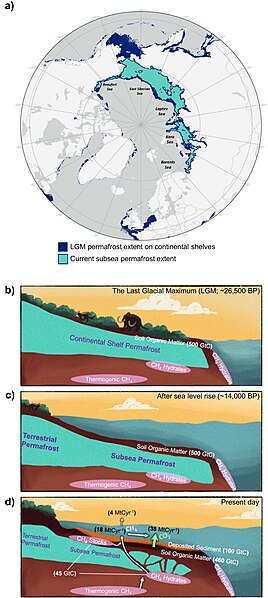Permafrost is soil or underwater sediment which continuously remains below 0 °C (32 °F) for two years or more: the oldest permafrost had been continuously frozen for around 700,000 years. While the shallowest permafrost has a vertical extent of below a meter (3 ft), the deepest is greater than 1,500 m (4,900 ft). Similarly, the area of individual permafrost zones may be limited to narrow mountain summits or extend across vast Arctic regions. The ground beneath glaciers and ice sheets is not usually defined as permafrost, so on land, permafrost is generally located beneath a so-called active layer of soil which freezes and thaws depending on the season.

Permafrost temperature profile. Permafrost occupies the middle zone, with the active layer above it, while geothermal activity keeps the lowest layer above freezing. The vertical 0 °C or 32 °F line denotes the average annual temperature that is crucial for the upper and lower limit of the permafrost zone, while the red lines represent seasonal temperature changes and seasonal temperature extremes. Solid curved lines at the top show seasonal maximum and minimum temperatures in the active layer, while the red dotted-to-solid line depicts the average temperature profile with depth of soil in a permafrost region.
Excavating ice-rich permafrost with a jackhammer in Alaska.
Changes in subsea permafrost extent and structure between the Last Glacial Maximum and now.
A group of palsas, as seen from above, formed by the growth of ice lenses.
Frost is a thin layer of ice on a solid surface, which forms from water vapor that deposits onto a freezing surface. Frost forms when the air contains more water vapor than it can normally hold at a specific temperature. The process is similar to the formation of dew, except it occurs below the freezing point of water typically without crossing through a liquid state.
A patch of grass showing three zones. crystalline frost in the below-freezing shade (blue, lower right) frost in the warming but still below freezing strip most recently exposed to sunlight (white, center) frost-free region: here, the previous frost has melted from a more prolonged exposure to sunlight (green, upper left.)
A spider web covered in air hoar frost
Hoar frost on the snow
Depth hoar, imaged with optical (left) and scanning electron (right) microscopy








